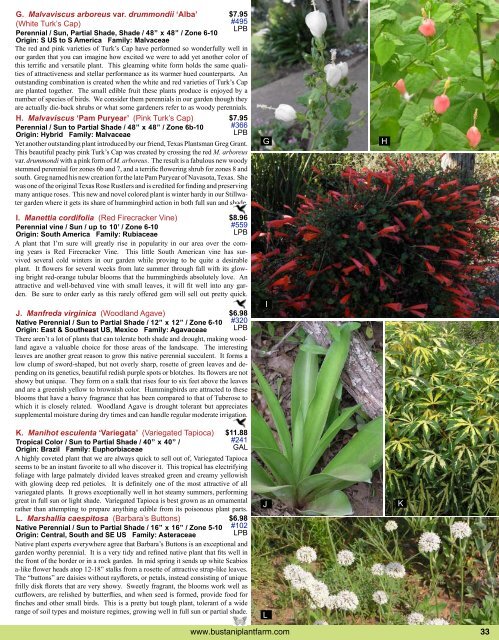Download Catalog - Bustani Plant Farm
Download Catalog - Bustani Plant Farm
Download Catalog - Bustani Plant Farm
Create successful ePaper yourself
Turn your PDF publications into a flip-book with our unique Google optimized e-Paper software.
G. Malvaviscus arboreus var. drummondii ‘Alba’<br />
(White Turk’s Cap)<br />
Perennial / Sun, Partial Shade, Shade / 48” x 48” / Zone 6-10<br />
Origin: S US to S America Family: Malvaceae<br />
$7.95<br />
#495<br />
LPB<br />
The red and pink varieties of Turk’s Cap have performed so wonderfully well in<br />
our garden that you can imagine how excited we were to add yet another color of<br />
this terrific and versatile plant. This gleaming white form holds the same qualities<br />
of attractiveness and stellar performance as its warmer hued counterparts. An<br />
outstanding combination is created when the white and red varieties of Turk’s Cap<br />
are planted together. The small edible fruit these plants produce is enjoyed by a<br />
number of species of birds. We consider them perennials in our garden though they<br />
are actually die-back shrubs or what some gardeners refer to as woody perennials.<br />
H. Malvaviscus ‘Pam Puryear’ (Pink Turk’s Cap)<br />
Perennial / Sun to Partial Shade / 48” x 48” / Zone 6b-10<br />
Origin: Hybrid Family: Malvaceae<br />
$7.95<br />
#366<br />
LPB<br />
Yet another outstanding plant introduced by our friend, Texas <strong>Plant</strong>sman Greg Grant.<br />
This beautiful peachy pink Turk’s Cap was created by crossing the red M. arboreus<br />
var. drummondi with a pink form of M. arboreus. The result is a fabulous new woody<br />
stemmed perennial for zones 6b and 7, and a terrific flowering shrub for zones 8 and<br />
south. Greg named his new creation for the late Pam Puryear of Navasota, Texas. She<br />
was one of the original Texas Rose Rustlers and is credited for finding and preserving<br />
many antique roses. This new and novel colored plant is winter hardy in our Stillwater<br />
garden where it gets its share of hummingbird action in both full sun and shade.<br />
I. Manettia cordifolia (Red Firecracker Vine)<br />
Perennial vine / Sun / up to 10’ / Zone 6-10<br />
Origin: South America Family: Rubiaceae<br />
$8.96<br />
#559<br />
LPB<br />
A plant that I’m sure will greatly rise in popularity in our area over the coming<br />
years is Red Firecracker Vine. This little South American vine has survived<br />
several cold winters in our garden while proving to be quite a desirable<br />
plant. It flowers for several weeks from late summer through fall with its glowing<br />
bright red-orange tubular blooms that the hummingbirds absolutely love. An<br />
attractive and well-behaved vine with small leaves, it will fit well into any garden.<br />
Be sure to order early as this rarely offered gem will sell out pretty quick.<br />
J. Manfreda virginica (Woodland Agave)<br />
Native Perennial / Sun to Partial Shade / 12” x 12” / Zone 6-10<br />
Origin: East & Southeast US, Mexico Family: Agavaceae<br />
$6.98<br />
#320<br />
LPB<br />
There aren’t a lot of plants that can tolerate both shade and drought, making woodland<br />
agave a valuable choice for those areas of the landscape. The interesting<br />
leaves are another great reason to grow this native perennial succulent. It forms a<br />
low clump of sword-shaped, but not overly sharp, rosette of green leaves and depending<br />
on its genetics, beautiful redish purple spots or blotches. Its flowers are not<br />
showy but unique. They form on a stalk that rises four to six feet above the leaves<br />
and are a greenish yellow to brownish color. Hummingbirds are attracted to these<br />
blooms that have a heavy fragrance that has been compared to that of Tuberose to<br />
which it is closely related. Woodland Agave is drought tolerant but appreciates<br />
supplemental moisture during dry times and can handle regular moderate irrigation.<br />
K. Manihot esculenta ‘Variegata’ (Variegated Tapioca)<br />
Tropical Color / Sun to Partial Shade / 40” x 40” /<br />
Origin: Brazil Family: Euphorbiaceae<br />
A highly coveted plant that we are always quick to sell out of, Variegated Tapioca<br />
seems to be an instant favorite to all who discover it. This tropical has electrifying<br />
foliage with large palmately divided leaves streaked green and creamy yellowish<br />
with glowing deep red petioles. It is definitely one of the most attractive of all<br />
variegated plants. It grows exceptionally well in hot steamy summers, performing<br />
great in full sun or light shade. Variegated Tapioca is best grown as an ornamental<br />
rather than attempting to prepare anything edible from its poisonous plant parts.<br />
L. Marshallia caespitosa (Barbara’s Buttons)<br />
Native Perennial / Sun to Partial Shade / 16” x 16” / Zone 5-10<br />
Origin: Central, South and SE US Family: Asteraceae<br />
$11.88<br />
#241<br />
GAL<br />
$6.98<br />
#102<br />
LPB<br />
Native plant experts everywhere agree that Barbara’s Buttons is an exceptional and<br />
garden worthy perennial. It is a very tidy and refined native plant that fits well in<br />
the front of the border or in a rock garden. In mid spring it sends up white Scabios<br />
a-like flower heads atop 12-18” stalks from a rosette of attractive strap-like leaves.<br />
The “buttons” are daisies without rayflorets, or petals, instead consisting of unique<br />
frilly disk florets that are very showy. Sweetly fragrant, the blooms work well as<br />
cutflowers, are relished by butterflies, and when seed is formed, provide food for<br />
finches and other small birds. This is a pretty but tough plant, tolerant of a wide<br />
range of soil types and moisture regimes, growing well in full sun or partial shade.<br />
G<br />
I<br />
J<br />
L<br />
www.bustaniplantfarm.com 33<br />
H<br />
K


